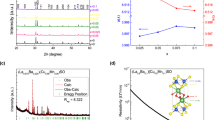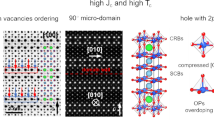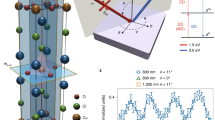Abstract
Materials that combine coupled electric and magnetic dipole order are termed ‘magnetoelectric multiferroics’1,2,3,4. In the past few years, a new class of such materials, ‘induced-multiferroics’, has been discovered5,6, wherein non-collinear spiral magnetic order breaks inversion symmetry, thus inducing ferroelectricity7,8,9. Spiral magnetic order often arises from the existence of competing magnetic interactions that reduce the ordering temperature of a more conventional collinear phase10. Hence, spiral-phase-induced ferroelectricity tends to exist only at temperatures lower than ∼40 K. Here, we propose that copper(II) oxides (containing Cu2+ ions) having large magnetic superexchange interactions11 can be good candidates for induced-multiferroics with high Curie temperature (TC). In fact, we demonstrate ferroelectricity with TC=230 K in cupric oxide, CuO (tenorite), which is known as a starting material for the synthesis of high-Tc (critical temperature) superconductors. Our result provides an important contribution to the search for high-temperature magnetoelectric multiferroics.
This is a preview of subscription content, access via your institution
Access options
Subscribe to this journal
Receive 12 print issues and online access
$259.00 per year
only $21.58 per issue
Buy this article
- Purchase on Springer Link
- Instant access to full article PDF
Prices may be subject to local taxes which are calculated during checkout




Similar content being viewed by others
References
Hill, N. A. Why are there so few magnetic ferroelectrics? J. Phys. Chem. B 104, 6694–6709 (2000).
Fiebig, M. Revival of the magnetoelectric effect. J. Phys. D 38, R123–R152 (2005).
Khomskii, D. I. Multiferroics: Different ways to combine magnetism and ferroelectricity. J. Magn. Magn. Mater. 306, 1–8 (2006).
Eerenstein, W., Mathur, N. D. & Scott, J. F. Multiferroic and magnetoelectric materials. Nature 442, 759–765 (2006).
Cheong, S.-W. & Mostovoy, M. V. Multiferroics: A magnetic twist for ferroelectricity. Nature Mater. 6, 13–20 (2007).
Kimura, T. Spiral magnets as magnetoelectrics. Annu. Rev. Mater. Res. 37, 387–413 (2007).
Katsura, H., Nagaosa, N. & Balatsky, A. V. Spin current and magnetoelectric effect in noncollinear magnets. Phys. Rev. Lett. 95, 057205 (2005).
Kenzelmann, M. et al. Magnetic inversion symmetry breaking and ferroelectricity in TbMnO3 . Phys. Rev. Lett. 95, 087206 (2005).
Arima, T. Ferroelectricity induced by proper-screw type magnetic order. J. Phys. Soc. Japan 76, 073702 (2007).
Ramirez, A. P. Strongly geometrically frustrated magnets. Annu. Rev. Mater. Sci. 24, 453–480 (1994).
Kastner, M. A., Birgeneau, R. J., Shirane, G. & Endoh, Y. Magnetic, transport, and optical properties of monolayer copper oxides. Rev. Mod. Phys. 70, 897–928 (1998).
Shizmizu, T., Matsumoto, T., Goto, T., Yoshimura, K. & Kosuge, K. Magnetic dimensionality of the antiferromagnet CuO. J. Phys. Soc. Japan 72, 2165–2168 (2003).
Mizuno, Y. et al. Electronic states and magnetic properties of edge-sharing Cu–O chains. Phys. Rev. B 57, 5326–5334 (1998).
Tsukada, I. et al. BaCu2Si2O7: A quasi-one-dimensional S=1/2 antiferromagnetic chain system. Phys. Rev. B 60, 6601–6607 (1999).
Masuda, T. et al. Spin waves and magnetic interactions in LiCu2O2 . Phys. Rev. B 72, 014405 (2005).
Enderle, M. et al. Quantum helimagnetism of the frustrated spin-1/2 chain LiCuVO4 . Europhys. Lett. 70, 237–243 (2005).
Park, S., Choi, Y. J., Zhang, C. L. & Cheong, S.-W. Ferroelectricity in an S=1/2 chain cuprates. Phys. Rev. Lett. 98, 057601 (2007).
Naito, Y. et al. Ferroelectric transition induced by the incommensurate magnetic ordering in LiCuVO4 . J. Phys. Soc. Japan 76, 023708 (2007).
Åsbrink, S. & Norrby, L.-J. A refinement of crystal structure of copper(II) oxide with a discussion of some exceptional e.s.d.’s. Acta Crystallogr. B 26, 8–15 (1970).
Yang, B. X., Thurston, T. R., Tranquada, J. M. & Shirane, G. Magnetic neutron scattering study of single-crystal cupric oxide. Phys. Rev. B 39, 4343–4349 (1989).
Forsyth, J. B., Brown, P. J. & Wanklyn, B. M. Magnetism in cupric oxide. J. Phys. C 21, 2917–2929 (1989).
Brown, P. J., Chattopadhyay, T., Forsyth, J. B., Nunez, V. & Tasset, F. Antiferromagnetism in CuO studied by neutron polarimetry. J. Phys. Condens. Matter 3, 4281–4287 (1991).
Ain, M., Menelle, A., Wanklyn, B. M. & Bertaut, E. F. Magnetic structure of CuO by neutron diffraction with polarization analysis. J. Phys. Condens. Matter 4, 5327–5338 (1992).
Köbler, U. & Chattopadhyay, T. On the magnetic anisotropy of CuO. Z. Phys. B 82, 383–386 (1991).
Ghisen, J. et al. Electronic-structure of Cu2O and CuO. Phys. Rev. B 38, 11322–11330 (1988).
Collins, B. T., DeSisto, W., Kershaw, R., Dwight, K. & Wold, A. Preparation and characterization of Cu(II) oxide. J. Less-Common Met. 156, 341–346 (1989).
Zheng, X. G. et al. Dielectric measurement to probe electron ordering and electron–spin interaction. J. Appl. Phys. 92, 2703–2708 (2002).
Sarkar, S., Kumar, J. P. K., Chaudhuri, B. K. & Sakata, H. Copper(II) oxide as giant dielectric material. Appl. Phys. Lett. 89, 212905 (2006).
Hoshino, S., Shimaoka, K. & Niimura, N. Ferroelectricity in solid hydrogen halides. Phys. Rev. Lett. 19, 1286–1288 (1967).
Prabhakaran, D. & Boothroyd, A. T. Single crystal growth of Zn-doped CuO by the floating zone method. J. Cryst. Growth 250, 77–82 (2003).
Acknowledgements
We thank H. Mukuda and M. Hagiwara for their help in electric measurements, and H. Fujiwara for his help in X-ray diffraction measurements. This work was supported by the 21st Century COE Program (G18) of the Japan Society for the Promotion of Science.
Author information
Authors and Affiliations
Corresponding author
Rights and permissions
About this article
Cite this article
Kimura, T., Sekio, Y., Nakamura, H. et al. Cupric oxide as an induced-multiferroic with high-TC. Nature Mater 7, 291–294 (2008). https://doi.org/10.1038/nmat2125
Received:
Accepted:
Published:
Issue Date:
DOI: https://doi.org/10.1038/nmat2125
This article is cited by
-
Stabilizing electromagnons in CuO under pressure
npj Quantum Materials (2023)
-
Octahedron distortion-triggered dipole–spin interaction in multiferroic magnetoelectric perovskites
NPG Asia Materials (2023)
-
On the dielectric properties and conduction mechanism in cuprous oxide thin films grown on (111)-oriented MgO substrates by means of non-reactive DC magnetron sputtering
Applied Physics A (2023)
-
Effects of Ni doping at Co-site on dielectric, impedance spectroscopy and AC-conductivity in La2CoMnO6 double perovskites
Applied Physics A (2022)
-
Ferroelectric domain walls for nanotechnology
Nature Reviews Materials (2021)



